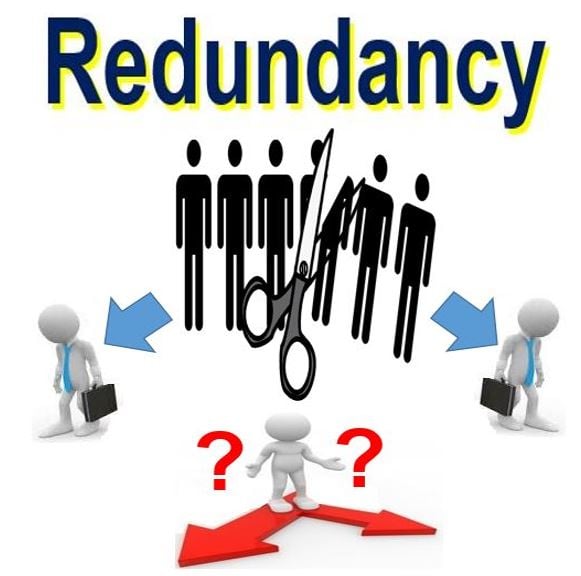If a Company Goes Bust Who Pays Redundancy? Lawful Insights for UK Worker
If a Company Goes Bust Who Pays Redundancy? Lawful Insights for UK Worker
Blog Article
Checking Out the Operational Characteristics of Firm Redundancy and Its Long-Term Sustainability

Redundancy Methods for Organization Continuity
In order to make certain uninterrupted procedures, businesses need to execute effective redundancy methods for service continuity. Redundancy in this context describes the duplication of essential elements or features within a system to minimize the influence of potential failures. By including redundancy techniques, companies can enhance their resilience versus disruptions brought on by various factors such as natural catastrophes, devices failures, or cyber-attacks.
One typical redundancy strategy is the execution of backup systems and data storage space solutions. This entails creating matches of essential data and systems that can be turned on in instance of a primary system failure. Additionally, companies can develop redundant interaction channels and source of power to preserve connectivity and procedures during unexpected events.
In addition, cross-training staff members to carry out multiple duties within the firm can act as a valuable redundancy approach. This makes sure that necessary jobs can still be performed even if vital workers are unavailable as a result of health problem or various other factors. On the whole, reliable redundancy approaches are important for organizations to support operational connection and lessen the effect of prospective interruptions.
Effect of Redundancy on Organizational Resilience
Offered the crucial role redundancy approaches play in ensuring organization continuity, exploring the effect of redundancy on business resilience becomes crucial for understanding the holistic operational dynamics of a business. Organizational resilience describes an entity's capability to adapt to disruptions, recover from obstacles, and change when needed while maintaining core functions. Redundancy, when tactically applied, can considerably contribute to improving a company's durability when faced with unexpected obstacles. By having back-up systems, employees, or procedures in location, companies can better withstand shocks and proceed procedures with very little interruption.
In addition, redundancy can promote advancement and creative thinking within an organization as staff members feel equipped to take computed risks, knowing that there is a safety internet to sustain them in instance of failing. On the whole, the impact of redundancy on organizational durability is extensive, shaping the lasting sustainability and success of a business.
Stabilizing Efficiency and Versatility in Redundancy
Attaining an unified balance in between functional performance and flexible adaptability is a pivotal difficulty in the critical implementation of redundancy within organizations. Also much adaptability without a solid operational structure can result in inadequacies and inconsistency.
To balance performance and adaptability in redundancy planning, companies need to thoroughly analyze their operational needs, market characteristics, and strategic goals. Ultimately, finding the ideal balance between efficiency and adaptability is crucial for building a lasting and resistant organization in the face of unpredictability.
Long-Term Sustainability With Redundancy Preparation
To make sure enduring stability and stability, organizations must purposefully align their redundancy planning with long-term sustainability goals, therefore integrating functional effectiveness with flexible flexibility. Long-term sustainability through redundancy planning includes greater than simply temporary cost-cutting procedures. It calls for an extensive critical technique that prepares for future challenges and opportunities. Companies must view redundancy not as a reactive remedy to immediate problems however as an aggressive method for long-lasting success. By integrating redundancy planning with sustainability goals, organizations can develop a durable framework that can hold up against different market variations and internal adjustments.

Aggressive Procedures for Sustainable Firm Procedures
How can firms proactively improve their functional sustainability for lasting success? Executing positive actions is vital for firms aiming to ensure sustainable procedures. One crucial strategy is to purchase technology and development to streamline processes, decrease waste, and remain affordable in the market. Adopting lasting methods such as lowering energy intake, decreasing carbon impact, and maximizing source application can not just profit the setting yet likewise lead to cost savings in the future.
Moreover, cultivating a society of constant improvement and knowing within the company can boost flexibility to altering market conditions and customer demands. Motivating worker involvement in decision-making procedures and supplying chances for specialist growth can improve morale, productivity, and total efficiency. Establishing clear objectives, checking essential efficiency signs, and on a regular basis evaluating progression are crucial components of aggressive sustainability administration.
Collaborating with providers, customers, and various other stakeholders to promote lasting methods throughout the supply chain can create a ripple effect of favorable impact - redundancy pay if company goes bust. By taking aggressive actions in the direction of operational sustainability, firms can develop strength, drive technology, and protect their long-term success in an ever-evolving service landscape
Conclusion

In the realm of business administration, the more tips here strategic release of business redundancy stands as a pivotal yet complex method that demands a delicate equilibrium between operational effectiveness and lasting feasibility. By dissecting the functional characteristics that underpin company redundancy and evaluating its broader implications for organizational resilience and versatility, a nuanced understanding of how redundancy strategies can form the future trajectory of a company begins to unravel.Given the important function redundancy approaches play in guaranteeing organization continuity, checking out the effect of redundancy on business resilience ends up being important for recognizing the holistic functional dynamics of a business. Overall, the influence of redundancy on business resilience is extensive, shaping the lasting sustainability and success of a firm.
In conclusion, understanding the operational dynamics of business redundancy is important for ensuring long-lasting sustainability.
Report this page